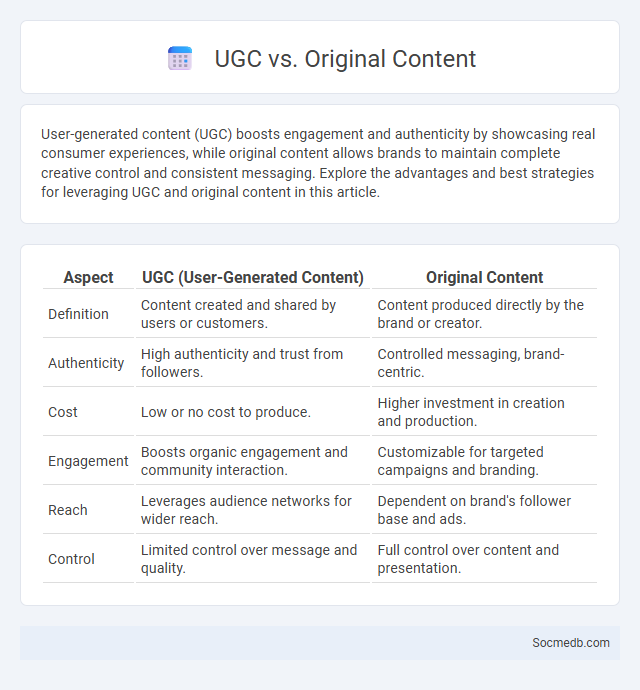
Photo illustration: UGC vs Original Content
User-generated content (UGC) boosts engagement and authenticity by showcasing real consumer experiences, while original content allows brands to maintain complete creative control and consistent messaging. Explore the advantages and best strategies for leveraging UGC and original content in this article.
Table of Comparison
| Aspect | UGC (User-Generated Content) | Original Content |
|---|---|---|
| Definition | Content created and shared by users or customers. | Content produced directly by the brand or creator. |
| Authenticity | High authenticity and trust from followers. | Controlled messaging, brand-centric. |
| Cost | Low or no cost to produce. | Higher investment in creation and production. |
| Engagement | Boosts organic engagement and community interaction. | Customizable for targeted campaigns and branding. |
| Reach | Leverages audience networks for wider reach. | Dependent on brand's follower base and ads. |
| Control | Limited control over message and quality. | Full control over content and presentation. |
Understanding UGC, Original Content, and User-Generated Content: Key Definitions
User-Generated Content (UGC) refers to any form of content--such as reviews, photos, videos, or posts--created by users rather than brands, offering authentic engagement and trust-building opportunities. Original Content is material produced by a brand or individual, showcasing creativity and control over messaging to establish authority and uniqueness. Understanding these distinctions empowers Your social media strategy, leveraging UGC for credibility and Original Content for brand identity.
Core Differences Between UGC and Original Content
User-Generated Content (UGC) differs from original content primarily in its source and authenticity; UGC is created by users or customers, often reflecting genuine experiences and opinions, while original content is professionally crafted by brands or creators to convey a specific message. UGC typically enhances social proof and trust, making it highly valuable for influencer marketing and community engagement, whereas original content allows for greater control over brand narrative and messaging consistency. Metrics such as engagement rates and conversion efficiency often vary, with UGC driving higher trust but original content ensuring alignment with strategic branding goals.
The Benefits of Using UGC in Your Marketing Strategy
User-generated content (UGC) significantly boosts social media marketing by increasing authenticity and trust among your audience, resulting in higher engagement rates and improved brand loyalty. Incorporating UGC into your marketing strategy leverages diverse customer perspectives, enhancing content relatability and driving organic reach across platforms like Instagram, TikTok, and Facebook. Your brand benefits from cost-effective content creation, as UGC reduces dependency on traditional advertising while fostering a strong community presence.
Advantages of Creating Original Content for Your Brand
Creating original content for your brand on social media enhances audience engagement by providing unique and valuable information tailored to your target market. It boosts brand authenticity and credibility, distinguishing your business from competitors and fostering customer trust. Original content also improves search engine optimization (SEO) performance, driving increased organic traffic and expanding your online visibility.
UGC vs Original Content: Which Drives Higher Engagement?
User-generated content (UGC) consistently drives higher engagement on social media platforms compared to original brand content due to its authenticity and relatability. When Your audience sees real people sharing genuine experiences, trust increases, leading to more likes, comments, and shares. Leveraging UGC alongside original content creates a dynamic strategy that amplifies overall brand interaction.
SEO Impact: User-Generated Content Versus Original Content
User-generated content (UGC) significantly boosts your SEO by increasing engagement, fostering community trust, and generating diverse keywords that naturally align with search intent. Original content remains essential for establishing authority and providing unique value, which search engines prioritize for ranking. Balancing UGC and original content optimizes your website's relevance, visibility, and organic traffic over time.
Challenges and Risks of Relying on UGC
Relying on User-Generated Content (UGC) poses challenges such as inconsistent quality, misinformation, and potential copyright violations, which can harm your brand's credibility. The risk of negative or offensive content being associated with your platform may lead to reputational damage and diminished user trust. Implementing effective moderation and clear guidelines is essential to mitigate these risks and maintain a positive online community.
Best Practices for Blending UGC and Original Content
Balancing user-generated content (UGC) with original content boosts authenticity and brand voice coherence across social media platforms. Incorporating UGC enhances trust and engagement by showcasing real customer experiences, while original content maintains strategic messaging and creative control. Effective blending involves curating high-quality UGC aligned with brand values and supplementing it with custom content that addresses specific marketing goals and trends.
Case Studies: Brands Successfully Leveraging UGC and Original Content
Brands like GoPro and Starbucks have leveraged user-generated content (UGC) to enhance engagement and authenticity on social media platforms. GoPro's UGC campaigns showcase real customer adventures, driving organic reach and brand loyalty through visually compelling content. Starbucks combines original content with UGC by encouraging customers to share their personalized drinks, creating a community-driven marketing approach that boosts interaction and brand visibility.
Future Trends: Evolving Strategies in Content Creation
Future trends in social media emphasize the rise of AI-driven content creation tools, enabling personalized and engaging user experiences. Interactive formats like augmented reality (AR) and virtual reality (VR) are becoming central to content strategies, enhancing audience immersion and retention. Data analytics and machine learning algorithms continue to refine targeting, ensuring content relevance and maximizing engagement across diverse platforms.
 socmedb.com
socmedb.com